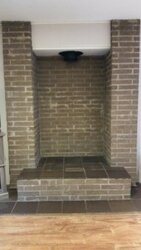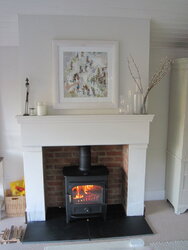

Hi there, on the left you will see my current situation (sad vacant spot where a wood stove used to stand, but the government did not permit us to keep it when we bought our home one year ago). On the right is the general look I would like to go for as we shop for a new stove. The problem that I am running into is the vertical clearance that is required to non-combustibles, i.e., the mantle. I have seen many pictures (on this forum included) that show a wood burning stove in a similar set-up as the above picture. What confuses me is when I look at the manuals of several different stoves, it lists the minimum vertical distance between the stove and anything else being anywhere from 60-84", which is much higher than I would like. Ideally we would like to mount our TV above the mantle. I just left my local stove shop and was told that there are very few alcove-approved stoves on the market now (in the style that I like), so my options are limited I guess. Can anyone provide any insight for me? Is the height requirement for what is directly above the plane of the front of the stove, or if the stove was positioned so that it extended slightly in front of the mantle, would that solve my problem? I hope this is making sense, and I am extremely thankful for any help as I am completely lost right now!

